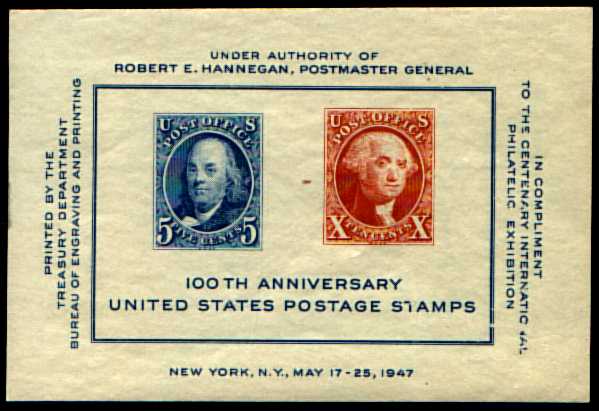

S is for Setenant |

|

|

|

|
Setenant is the French term for "joined". In philately, it refers to two or more stamps, on the same pane, but having different designs, denominations, or colors. Once rare, this has become the most popular style for US stamps, indeed for stamps world-wide. The traditional way to print stamps was one design to a pane, and in the days when all stamps were engraved, so there was significant time and effort involved in each design, that made sense. But as production methods evolved, there was little additional cost to multiple designs, and once the concept had been tried, and people liked it, it became the standard.
The first US issue designated as setenant was a block of four Christmas (holly) stamps in 1964, though there are earlier issues that could be considered setenants. Some might argue, for instance, that some of the earliest US stamps qualify, since while every stamp on a sheet shared the same design, denomination and color, production techniques were still so crude that there were significant differences amoung the stamps, and they are now collected as distinct issues. OK, I guess that's a stretch. How about 499/505? Does the fact that the two designs were printed together because of an error prevent us from calling that a setenant issue? Certainly the 1936, 1947, and 1956 souvenir sheets for TIPEX (Third International Stamp Exhibition) CIPEX (Centennial International Stamp Exhibition) and FIPEX (Fifth International Stamp Exhibition) qualify as setenants, if we allow souvenir sheets. So if you decide to collect this area, there are some choices to be made.
Setenants have become a popular collecting area. Among the more impressive examples was a fifty-stamp sheet in 1976 representing all 50 State Flags, the first of five (as of June, 2004) 50-design U.S. issues.
What was the first setenant world-wide? Help us answer
this burning question.
Click on any image below to view a high-res version
Setenants in the US

The first official setenant issue in the US was this one, the Christmas issue of 1964,
also called "Xmas Foliage". It was only the third US Christmas stamp. It was also one
of the first US stamps with tagging.
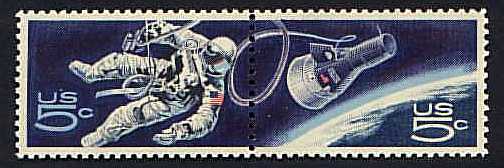
This was the second US setenant issue, released in 1967, almost three years after the
first. Why did it take them so long? This was also the first issue with a single image
continuous across more than one stamp. Its official name is "Accomplishments In Space
Issue," but it is usually referred to as the "Space Twins".
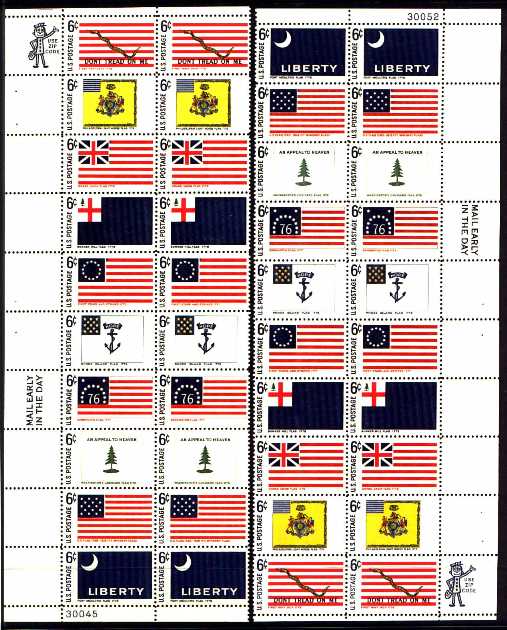
This was the third US setenant issue, released in 1968, less than a year after the
second. 1968 was the last calendar year in which there was only a single setenant issue
in the US. This one is called the "Historic Flag Issue", and depicts 10 different US
flags from the period 1775 to 1800. One interesting and innovative feature of its
printing was the arrangement of the designs, running in one direction on upper panes and
the other on lower panes. The strip on the left above is from a lower pane, the one on
the right from an upper. This illustrates one of the types of variations a collector of
setenants might want to pursue, i.e. not just the multiples per se, but the
different pane configurations.
Do you collect Flags On Stamps? Collector Bob Hunt has started a study group for that topic -
email him at "bh1861@att.net" and tell him you want to join.
OR visit his web site
to learn more.
And don't miss
Flags on Stamps by Richard Mallett.


The Xmas Foliage Issue, issued in panes of 100, had only one pane configuration, but the Space Twins had two, since it was issued in panes of 50, 5 across by ten down. Here's how that looked. Again, for a complete collection of all setenant formats, one would need a copy of each pane.
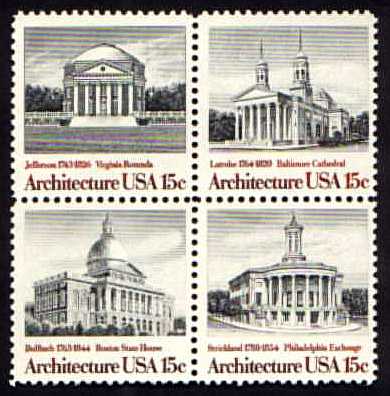
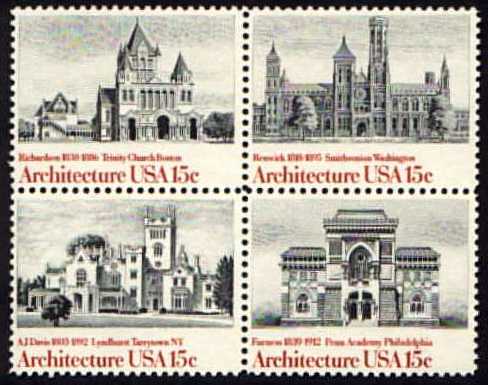

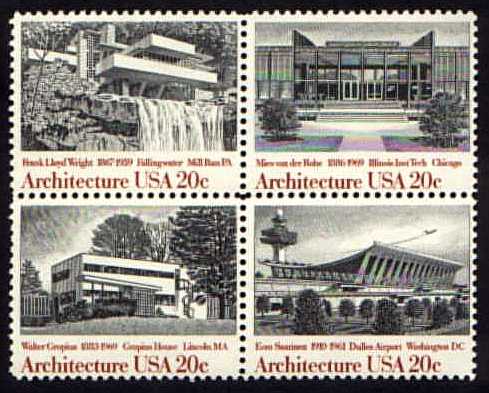
The American Architecture series was issued one block per year, 1979-1982. It's a
personal favorite of mine - partly because of its use of engraving, and its elegant
simplicity of design, but also because I once considered a career as an architect, so the
topic interests me per se.
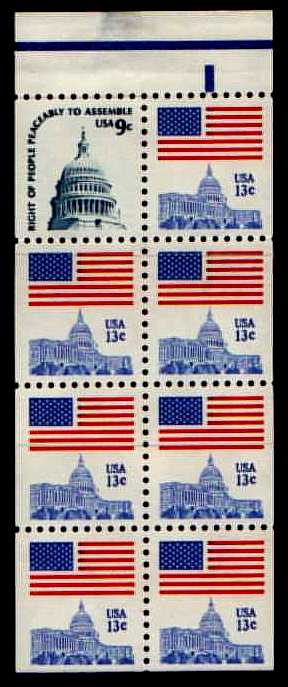
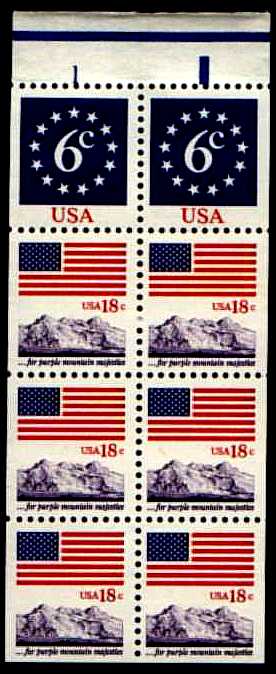
These two issues are unusual in that the mixed designs were motivated by the desire to
give the value of the pane a round number - $1.00 for the one on the left, released in
1976, and $1.20 for the one on the right, released in 1981 - rather than the specific
intention to create a setentant. But they still qualify, by my standards. They were the
first definitive stamps printed setenant,
and like all definitive setenants, were released as booklets.
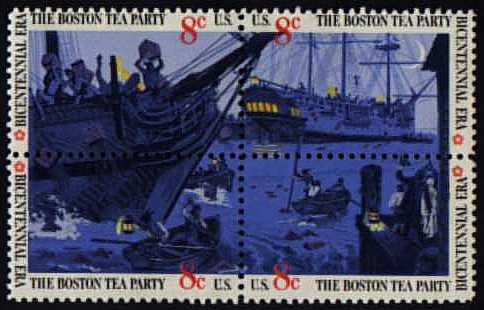


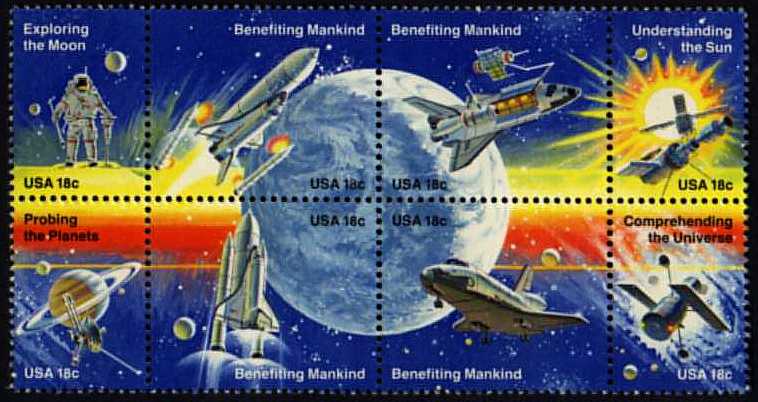
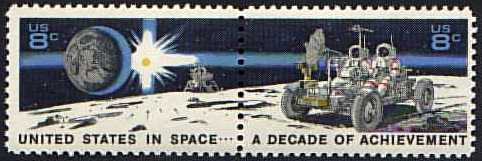
Just some more examples of designs that span more than one stamp, which I particularly
like. The top three were part of the flood of issues for the US Bi-centennial. You can
see that space is a popular theme for setenants, as well as for stamps in general.

As perforating equipment has become more sophisticated, arrangements like this, which
could not have been done a few years earlier, have become possible. These were released
in 1981.
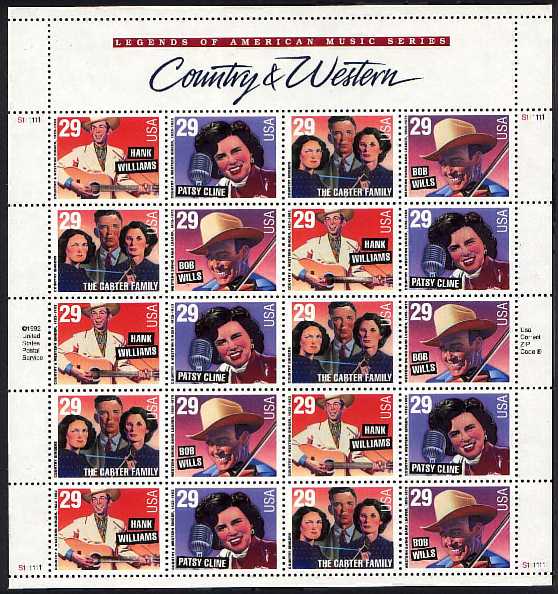
This Country & Western pane (1993) was one of the first to use this format, which has
been used many times since, with the title in a bar at the top, and twenty stamps with
anywhere from two to twenty different designs arranged in multitudinous ways on the pane.
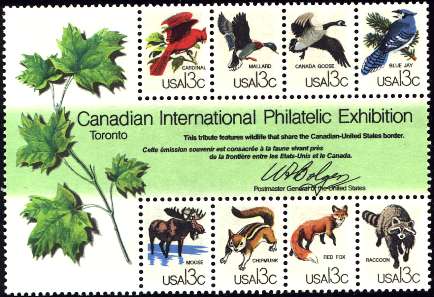 |
 |
 |
This souvenir sheet for the 1978 Canadian Philatelic Exhibition (CAPEX) had an innovative sheet layout, lending itself to two very different ways of separating and displaying the stamps.
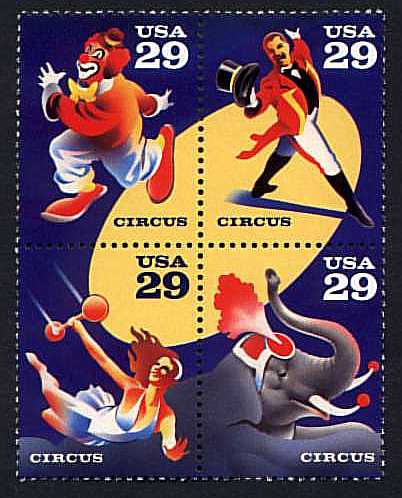
Here's another clever variation on the idea of a single image that spans several stamps.
The challenge, I think, is to create a design that works as a whole, yet also as the
individual pieces, or stamps. On this one, issued in 1993, the unifying element is that
spotlight - aside from it the four performers would not seem to be in the same place, but
with it we see them all in a circus tent. Some people thought the block should have the
ringmaster and clown at the bottom, with the trapeze artist flying above them, but
elephants don't fly (except in cartoons), so I think it should look like this.
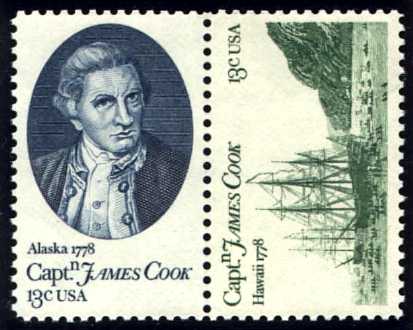
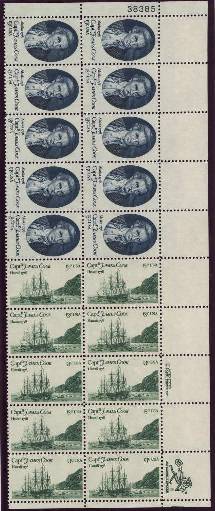
This was another unusual use of the concept - only in the two center rows of each pane
are the two designs setenant, and aside from the common theme, they do not seem to belong
together. I find it somewhat puzzling, as though the design comittee simply could not
agree which design to use, so grudgingly compromised on both - why not alternate them
throughout the sheet?
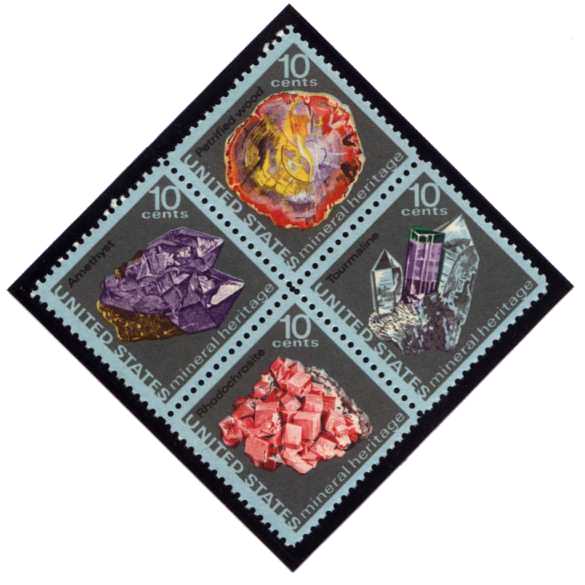
This was the first US "diamond-shaped" issue, in 1974. Some quibblers maintain this is
not a diamond, merely a square set on its corner, but my dictionary (the 1958 Random
House American College Dictionary given to me on my departure for college),
defines "diamond" as
"an equilateral quadrilateral, esp. as placed with its diagonals vertical and
horizontal". Looks like a diamond to me.

The pane above is one of only five issues (as of June 2004) with 50 different designs -
this one, in 1982,depicted the State Birds and Flowers. The others were
state flags,
wildlife,
wildflowers, and
Greetings From America
(issued twice, with 34¢ and then 37¢ denomination).
The 50-stamp pane format, once the standard for commemoratives, was abandoned several years ago - people seem to
prefer smaller panes, and self-adhesives - so it was a surprise when they issued the most
recent ones, but they were popular, so we may see more.
The next largest number of different stamps per pane is 20 - there have been ten or so of
those. The first was the Legends of
the West, in 1994.
Here is an interesting web page about the development of the Greetings From America stamps.
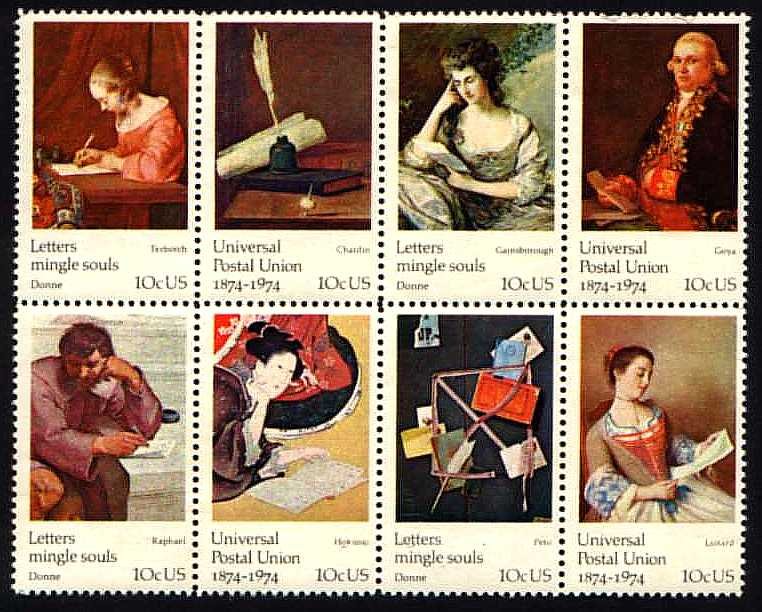
This one is a favorite of mine, for its theme the
UPU, as well as its beautiful design, which uses famous paintings to illustrate the
theme, "Letters Mingle Souls", a quotation from a famous letter written by John Donne to
a friend in 1598:
"Sir, more than kisses, letters mingle souls;
For, thus friends absent
speak."
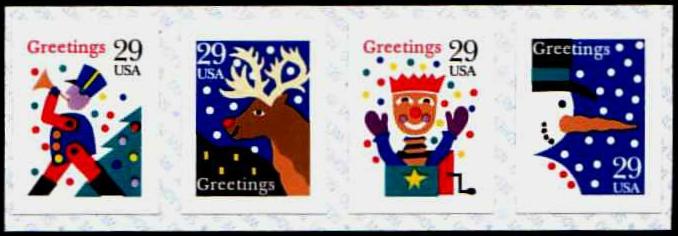
This was the first "self-adhesive coil" with setenant designs, in 1993. Self-adhesives
were still relatively new, but already very popular with the public, and the USPS could
see that a coil was needed, but this format had little to offer, consisting of simply
self-adhesive stamps on a strip of backing. It would not fit in any standard dispenser,
nor did it lend itself to use in automated affixing machines. I suspect that most of the
buyers were stamp collectors and dealers. There is a newer technology that permits real
coils, though it too has disadvantages for any but the brave of heart. It will be
interesting to see how this area develops. (I messed with the color and contrast to
bring out the stamps vs. the backing - the real stamps look much better than this - click
on the image to see the closeup, which is truer to the original.)
1/13/2002 - I visited my 87-year old father a few weeks ago, and saw him using a roll of
self-adhesive coils, which still consists of a backing from which the stamps must be
peeled, but he seemed right at home with it, so I guess the concept has arrived. They've
eliminated the spaces between the stamps, so it looks more like a traditional coil roll.
I could never figure out whether those spaces were a production necessity, or someone's
idea that people wouldn't understand the concept otherwise. In the end, I suspect most
postal patrons will use whatever a clerk hands them, they just want stamps, so
cost-effectiveness will decide what is offered.

This is a recent (June, 1999) favorite of mine - the design is cleverly executed, and
the stamps were printed using a higher "screen" than had been employed before, giving
them exceptional clarity and brilliance.
Statistics for Setenants on US stamps
Just in case you share my obsession with statistics, here are the numbers by year for
setenant issues in the US. The first number after the dash is the number of setenant
issues, and the second is the total number of issues. Not too bad, I guess.
1964-1/18; 1965-0/19; 1966-0/24; 1967-1/25; 1968-1/30; 1969-2/18;
1970-
4/24; 1971-3/28; 1972-3/24; 1973-2/29; 1974-3/22; 1975-4/31;
1976-7/20;
1977-4/25; 1978-7/35; 1979-6/27; 1980-6/20;
1981-8/49; 1982-5/36; 1983-7/37;
1984-4/39;
1985-4/58; 1986-6/33; 1987-5/37;
1988-6/54; 1989-7/24; 1990-6/27; 1991-5/66;
1992-12/39; 1993-17/44; 1994-11/78; 1995-12/68; 1996-12/56; 1997-9/45; 1998-
14/63; 1999-15/45
Want more? Note that I counted number of ISSUES, not stamps, above. If you want to see
the stamp totals as well,
Here's a table of total issue stamps per
year, vs. setenant issues and stamps per year.
Forerunners
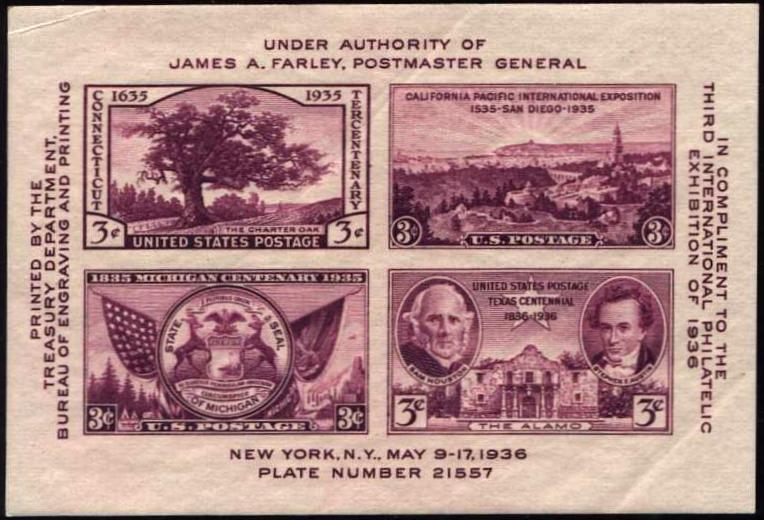
Some people would consider this a setenant issue, but since it was a souvenir sheet
issued in conjunction with a major US Philatelic Exhibition, in 1936, it is not generally
treated as one - souvenir sheets have always been regarded as philatelic creations, hence
subject to separate rules. There were two similar issues (below), i.e., souvenir sheets
issued in conjunction with philatelic exhibitions, in 1947 and 1956, each with two
different designs on the same souvenir sheet:
But if we exclude all of those, we should exclude all the more recent souvenir sheets as
well (see my list). So I call these "forerunners", and include them. If you decide to
collect setenants yourself, the choice is yours. That's one of the prerogatives of being
a collector - unless you choose to exhibit competitively (in which case there are RULES),
you get to decide what and how to collect.
Early U.S. stamps - Setenants?
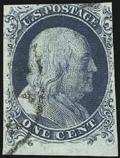
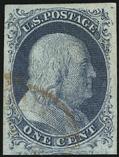


Finally just to carry this to absurdity, let's return to the idea I brought up back at the top of this page. Are there setenants among the earliest U.S. stamps? I'm talking about Scott 5 through 9, for instance, or Scott 13 through 16. Directly above are images of Scott 6,7,8, and 9. The uninitiated, looking at examples of those together, would assume they were all the same stamp. Indeed, they were issued as one stamp. The reasons for the multiple Scott numbers (all basically amounting to primitive equipment and skills) were fourfold - first, wear in the dies as the designs were transferred to the plates, second, wear on the plates as they were used, third, recutting of individual images on the plates ro repair the damage from use, and fourth, the differences among the original plates themselves, from wear on the die and uneven rocking-in. As to actually finding different Scott numbers setenant for 5-9 or 13-16, it is not possible for all combinations, but 14-15 is relatively common. Below is an image from a recent Siegel auction, of Scott 14-15 setenant.
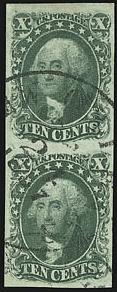
The actual differences between the two stamps are so subtle you need a guide and a high-power magnifier to discern them, but nonetheless I say these could be called setenants, and the only way to exclude them is by how one defines the term. To me the key is intent. If the designs were supposed to be the same, and varied because of wear and tear, the result is just multiple varieties, not different stamps. Indeed, when I collected early U.S., I ignored these distinctions entirely, they were just interesting curiosities. To me Scott 13 through 16 are all the same stamp, and all I needed was an example of the cheapest. OK, the fact that I couldn't have afforded more than the cheapest ones may have been a factor in that choice.
Setenants abroad
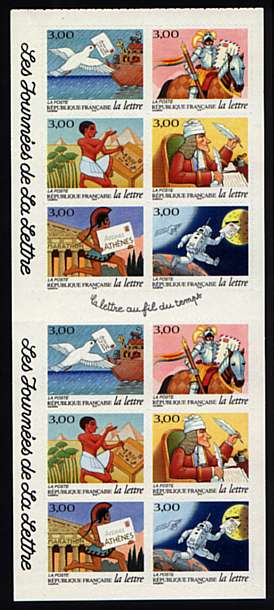
|
Many other countries have issued setenants, of course, and you can find examples scattered around my web site, e.g., on my "G" page. Here are some recent ones from France, issued both as lick-and-stick sheet stamps and as self-adhesive booklets. The topic is letters, and how mail carrying methods have advanced over the ages. |

|
WHAT WAS THE FIRST SETENANT WORLD-WIDE?
GREAT NEW WEB SITE. I just discovered Nick Blackburn's very informative and entertaining site, with a page that lists various firsts worldwide, including "First Composite:"
http://www.snap-dragon.com/first_firsts.htm - The first examples worldwide of various types of stamps, such as First Airmail, First Booklet, First Multi-lilngual, etc. And First Composite.
"Composite" means a setenant design that is continuous over two or more stamps, like the U.S. "Space Twins" at the top of this page. According to Nick, the first of those issued worldwide was Scott Poland 767-68, issued in 1957.
There were other setenant issues before that, of course, they just weren't composite designs.
So Nick and I wondered, What was the first setenant world-wide? Of any sort.
CLICK HERE to find out.
| Home | R is for RPO <<< | Contents | >>> T is for Topical stamps | Credits |
All text Copyright © 2000, William M. Senkus
Send feedback to the webmaster: CLICK HERE
Revised -- 12/03/2004

